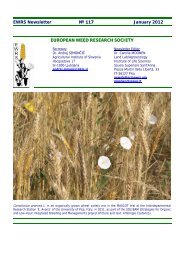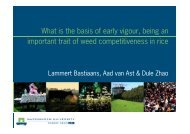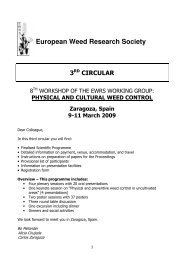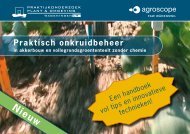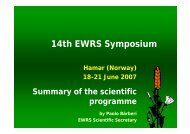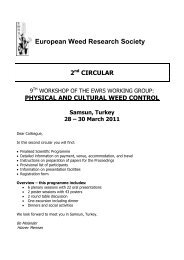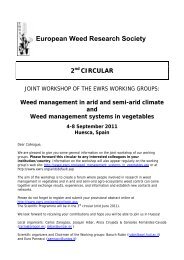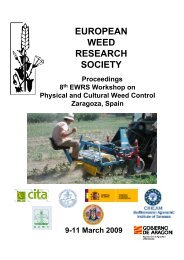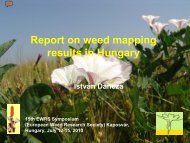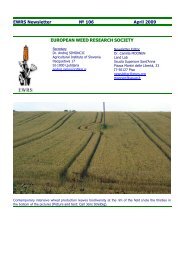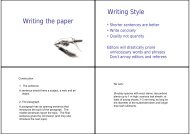Physical and Cultural Weed Control Working Group of - European ...
Physical and Cultural Weed Control Working Group of - European ...
Physical and Cultural Weed Control Working Group of - European ...
You also want an ePaper? Increase the reach of your titles
YUMPU automatically turns print PDFs into web optimized ePapers that Google loves.
9 th EWRS Workshop on <strong>Physical</strong> <strong>and</strong> <strong>Cultural</strong> <strong>Weed</strong> <strong>Control</strong> 68<br />
Samsun, Turkey, 28 – 30 March 2011<br />
Leaf RWC Determination. For each plant species <strong>and</strong> timing <strong>of</strong> flaming, one set <strong>of</strong> three pots<br />
were kept aside only for leaf RWC determination. These plants did not receive any flaming<br />
treatments. Leaf RWC was determined according to the st<strong>and</strong>ard method <strong>of</strong> Barrs <strong>and</strong> Weatherley<br />
(1962). A composite sample <strong>of</strong> leaf discs from each plant was weighted immediately, providing a<br />
measure <strong>of</strong> fresh weight (FW). After weighing, the disks were soaked in deionized water for 24 h<br />
<strong>and</strong> then weighted again to obtain a fully turgid weight (TW). Finally, the leaf discs were ovendried<br />
to a constant weight at about 85 C <strong>and</strong> weighted to get a dry weight (DW). The leaf RWC is<br />
calculated as follows (Barrs <strong>and</strong> Weatherley 1962):<br />
RWC = (FW – DW) / (TW – DW) [1]<br />
Although originally defined as a percentage, leaf RWC is now commonly expressed in decimal<br />
form (Smart <strong>and</strong> Bingham 1974) <strong>and</strong> this convention is followed in our studies (Table 2).<br />
Flaming Procedure. Flaming was done at four times <strong>of</strong> day (0, 4, 8, <strong>and</strong> 12 HAS), which covered<br />
four different leaf RWC. To obtain different leaf RWC, the soil in each pot was watered up to field<br />
capacity at 6 P.M. <strong>of</strong> the previous day, thus flaming was done approximately at 12, 16, 20, <strong>and</strong> 24 h<br />
after watering. Flaming treatment was conducted utilizing a h<strong>and</strong>held flamer with a single VT 2-<br />
23C vapor phase burner 1 positioned 20 cm above soil surface <strong>and</strong> angled horizontally at 30˚. The<br />
propane pressure was 120 kPa, which produced a flow rate <strong>of</strong> 95 g h –1 . The application speeds<br />
(conducted by walking) were 1.6, 3.2, <strong>and</strong> 4.8 km h –1 , which corresponded to the propane doses <strong>of</strong><br />
87, 43, <strong>and</strong> 29 kg ha –1 , respectively.<br />
Visual Plant Injury Estimation <strong>and</strong> Fresh Weight. Visual plant injury was assessed at 1, 3, <strong>and</strong> 7<br />
d after treatment (DAT) using a scale from 0 to 100%, where 0 represented no plant injury based on<br />
the nonflamed plants, <strong>and</strong> 100 represented plant death. At 7 DAT, each plant species was clipped at<br />
the soil surface <strong>and</strong> shoot fresh weight was recorded.<br />
Statistical Analyses. Analysis <strong>of</strong> variance (ANOVA) was performed by the PROC GLIMMIX<br />
procedure in SAS (SAS Institute 2005) to test for the significance (P < 0.05) <strong>of</strong> experimental runs,<br />
treatments, replications, <strong>and</strong> their interactions on the basis <strong>of</strong> the visual ratings <strong>of</strong> plant injury <strong>and</strong><br />
fresh weight data. There were no significant interaction effects <strong>of</strong> treatment <strong>and</strong> experimental run;<br />
therefore, the data were pooled over two experimental runs. Data were subjected to a non-linear<br />
regression analysis <strong>and</strong> were analyzed using the four-parameter log-logistic model (Seefeldt et al.<br />
1995):<br />
Y = C + (D − C) / {1 + exp[B(log X − log E)]} [2]<br />
where Y is the response (e.g., percent injury), C is the lower limit, D is the upper limit, X is the<br />
propane dose, E is the dose resulting in a 50% response between the upper <strong>and</strong> lower limit (also<br />
known as inflection point, I50 or ED50), <strong>and</strong> B is the slope <strong>of</strong> the line at the inflection point (also<br />
known as a rate <strong>of</strong> change). All statistical analysis <strong>and</strong> graphs were performed with the open-source<br />
statistical s<strong>of</strong>tware R 2.3.0 2 utilizing the dose–response curves (drc) statistical addition package<br />
(Knezevic et al. 2007). For visual plant injury, the hours after sunrise when flaming resulted in a<br />
90% <strong>of</strong> the maximum injury (HAS90) for crops <strong>and</strong> weed species were calculated from Figure 1b<br />
<strong>and</strong> presented in Table 4. Time <strong>of</strong> day that corresponded to each HAS90 value in Table 4, was<br />
calculated on the basis <strong>of</strong> an arbitrarily assigned day <strong>of</strong> June 15, 2009.<br />
Results <strong>and</strong> Discussion<br />
Plant Injury. Significant interaction (P = 0.02) between propane dose <strong>and</strong> time <strong>of</strong> day was<br />
observed with the visual plant injury data at 7 DAT (Figures 1a–b). All plant species exhibited more<br />
injury when flamed during the afternoon, particularly at 12 HAS (Figure 1a). There were no<br />
differences in the injury levels among 0, 4, <strong>and</strong> 8 HAS treatments for most <strong>of</strong> the plant species



